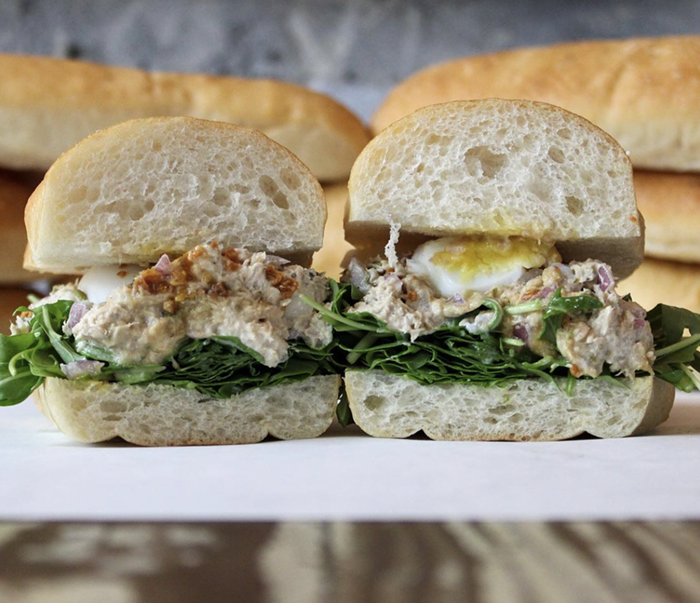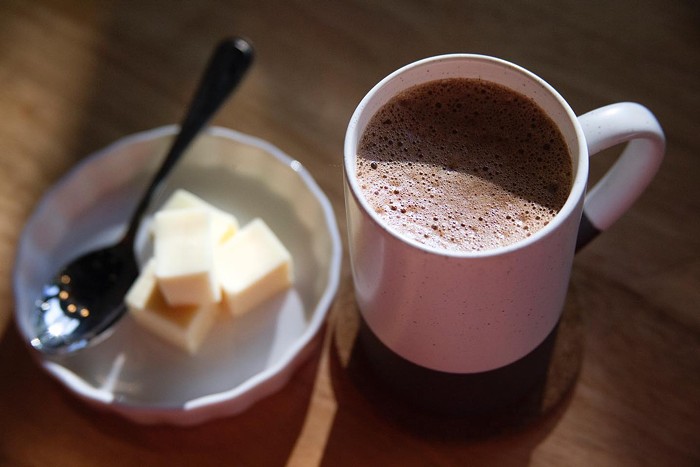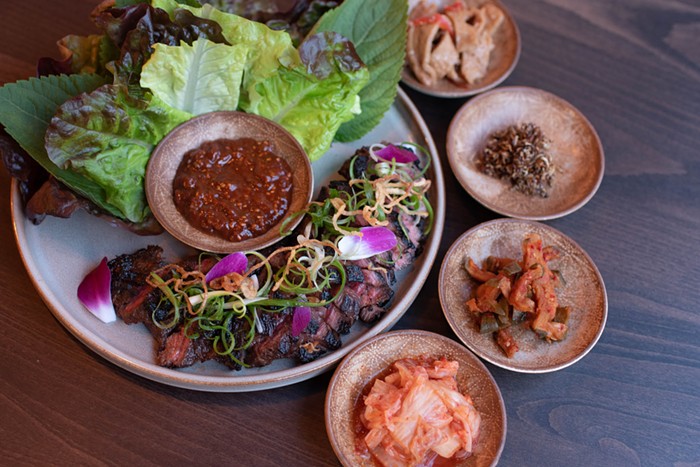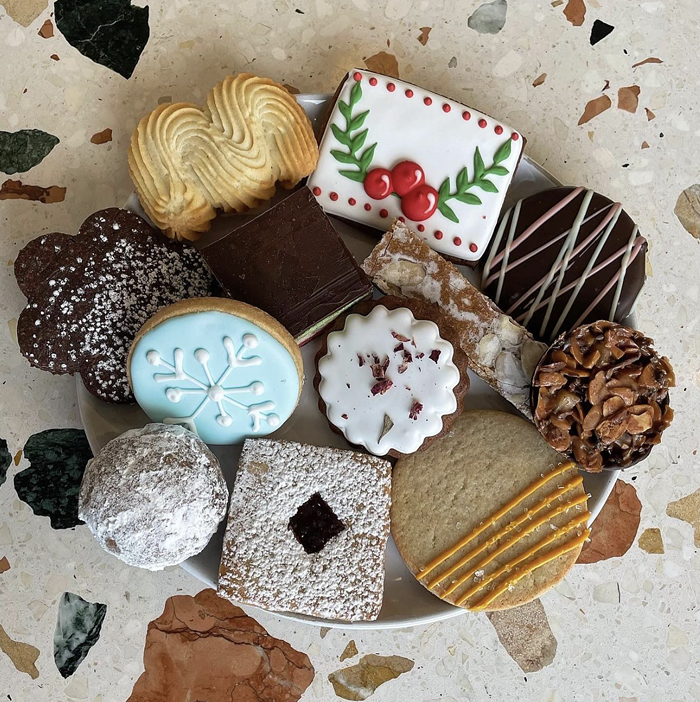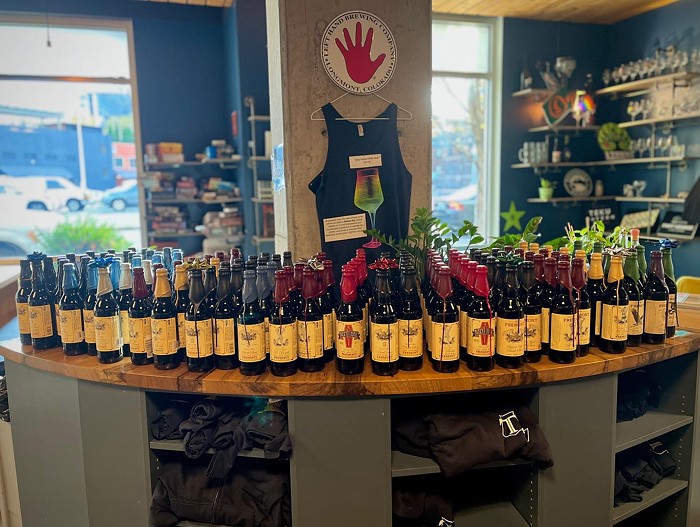LOWER QUEEN ANNE'S CREDENZIA Oven is remarkable on several fronts. The Georgian and Mediterranean creations of noted local chef Laura Dewell can leave the diner feeling like one very fortunate farm boy, while the restaurant's self-consciously simple design encourages dreamy fantasies. Pretend you are a Russian peasant, just in from a long day of milking some sort of exotic farm animal. You get to eat in a very special barn, equipped with a huge skylight and elegantly crude tables and chairs. Billowing curtains hint at formality or royalty, suggesting that maybe you are more than just a peasant. Maybe you are something very special--perhaps a traveling king from Prussia, someone who deserves to be fed attractive and wholesome food, the kind of food Credenzia does so well.
As you might guess, Credenzia's design can come across as extremely mannered. A gargantuan (six tons!) and phallic clay oven juts aggressively skyward, looking more like an incinerator than something you'd bake bread in. To Dewell's credit, the oven wasn't her idea. Originally Credenzia Oven was Credenzia Village Bakery; the current incarnation emerged when the bakery took a dive and the owners brought Dewell in. The happy diner would do well to ignore the clay monstrosity and focus on the heart-breakingly delicious food.
The Mezze Plate ($12.95) is simply unstoppable, and must wear the mantle of all-city champion meal-starter. This three-way sampler bathes one's gustational components with fattoush (a modest yet attractive pile of cucumbers, greens, peppers, sumac, and mint), dolmas (shiny and firm vine leaves stuffed with figs, lentils, and bulgur), and havuc koftesi (inspiring carrot/herb fritters with apricots, pine nuts, and a yogurt garlic sauce). Puri, the accompanying bread, is an absolute Soviet show-stopper. For the uninitiated, puri might seem a little raw and doughy, but as you experiment with its various uses, you'll agree that it's a versatile little side bread. With its EZ-grip texture and flat-yet-puffy essence, puri buddies up with just about everything Credenzia can throw at you.
Our Torta Genovese ($12) advanced the flatbread situation nicely. Stuffed with chard, feta, and potatoes, this lean and modestly cheesed pastry allowed the potatoes to strut their rooty and woody little attributes with grace. Stuffed mushrooms on the side seemed a bit arbitrary, and had a crunchy texture reminiscent of firm dirt. In keeping with the evening's emerging flatbread theme, the Spinach-Mushroom-Chevre and Basil Pizza ($10) showcased Captain Dewell's rock-solid commitment to simple plan, adept execution, and fresh ingredients. Nothing can ruin a pizza quicker than a chef with a heavy chevre hand; Dewell would allow no such nonsense. Strategically placed mini-balls of the naturally rank taste-provoker enhanced and mingled with the lushly verdant basil, creating a balanced and diverse symphony of flavor, all on a thin crust marked by blazing whiteness.
Although the massive and daunting oven suggests architectural parody, the bread baked within its womb is undeniably excellent. Our gifted server, Kelly, told us that the fittingly giant circular loaves are a Romanian bread, a combination of the Rumania and Campagne styles. Its chewy, pale interior perfectly acquiesced to its inevitable crusty shell. Seattle is swimming in good bread, and Credenzia's leads the way.
Woody and reeking of vast fruity orchards, Oregon's Erath Vineyards Pinot Noir ($6.25) came on like a load of oak, leaving a sweet vapor floating around the glass. This feisty yet understated little pinot modestly complemented the evening's starch-fest. The dessert menu was tantalizing, leading us to the Mascarpone Ice Cream ($6.25) over Sage Cake, which sat comfortably in a modest pool of port-soaked cherries. Presented with admirable structural integrity, this dessert insinuated a mock-up of the U.S. Capitol, with the round scoop of ice-cream serving as a creamy rotunda. The cherries and port thoroughly soaked the cake; although the boastful port flavor overwhelmed the subtle nuances of the ice cream, the cool dairy texture served to restrain it.
Sitting in an oddly over-height dining room felt un-American, in a good way. While the thoughtful character of the room captured the American fascination with design, the resulting ambience indeed felt foreign and farm-ish.
The rough, mismatched wooden chairs created an aesthetic dissonance with the fine and lovingly prepared food, further defining the country feel. The uncomfortably hard and angular chair did, however, distract from the enjoyment of the meal. Perhaps Credenzia could go one step further toward the country peasant theme and allow diners to sit on goats, who would be softer and more forgiving in the fanny area.

